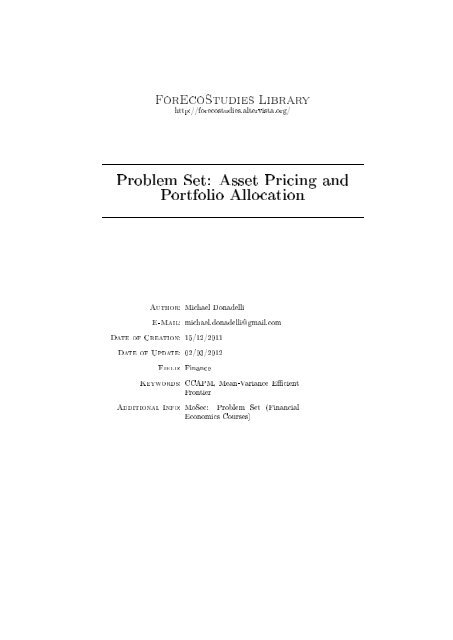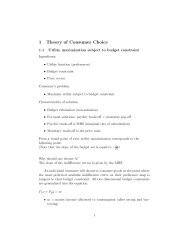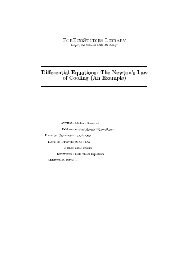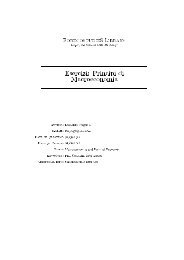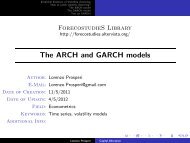Problem Set: Asset Pricing and Portfolio Allocation - ForEcoStudies
Problem Set: Asset Pricing and Portfolio Allocation - ForEcoStudies
Problem Set: Asset Pricing and Portfolio Allocation - ForEcoStudies
Create successful ePaper yourself
Turn your PDF publications into a flip-book with our unique Google optimized e-Paper software.
<strong>ForEcoStudies</strong> Library<br />
http://forecostudies.altervista.org/<br />
<strong>Problem</strong> <strong>Set</strong>: <strong>Asset</strong> <strong>Pricing</strong> <strong>and</strong><br />
<strong>Portfolio</strong> <strong>Allocation</strong><br />
Author: Michael Donadelli<br />
E-Mail: michael.donadelli@gmail.com<br />
Date of Creation: 15/12/2011<br />
Date of Update: 02/03/2012<br />
Field: Finance<br />
Keywords: CCAPM, Mean-Variance Ecient<br />
Frontier<br />
Additional Info: MoSec: <strong>Problem</strong> <strong>Set</strong> (Financial<br />
Economics Courses)
<strong>Problem</strong> <strong>Set</strong> III<br />
Exercise 2.3<br />
Consider a two period economy with I agents <strong>and</strong> J risky assets, <strong>and</strong> one risk-free asset. Agent’s<br />
wealth is defined as follows:<br />
⎛ ⎞<br />
Ỹ i =<br />
⎝Y i<br />
0 − ∑ j<br />
x i j<br />
⎠ (1 + r f ) + ∑ j<br />
x i j (1 + ˜r j )<br />
Y0 i = agent i’ initial wealth<br />
r f = riskfree interest rate<br />
˜r j = r<strong>and</strong>om rate of return on the risky asset j<br />
x i j = amount invested in asset j by agent i<br />
.<br />
The individual’s choice problem is,<br />
max x i<br />
j<br />
E[U i (Ỹi)]<br />
Let’s now substitute Ỹi in the utility function. We obtain:<br />
⎡ ⎛⎛<br />
⎞<br />
max x i<br />
j<br />
E ⎣U i<br />
⎝⎝Y 0 i − ∑ x i ⎠<br />
j (1 + r f ) + ∑<br />
j<br />
j<br />
⎞⎤<br />
x i j (1 + ˜r j ) ⎠⎦<br />
or<br />
⎡ ⎛<br />
max x i<br />
j<br />
E ⎣U i<br />
⎝Y 0 i + Y0 i r f − ∑ j<br />
x i j − ∑ j<br />
x i jr f + ∑ j<br />
x i j + ∑ j<br />
⎞⎤<br />
x i j ˜r j<br />
⎠⎦<br />
First Order Condition:<br />
∂E[U i (Ỹi)]<br />
∂x i j<br />
= 0<br />
⇒ E[U ′ (Ỹi)(−1 − r f + 1 + ˜r j )] = 0<br />
⇒ E[U ′ (Ỹi)(˜r j − r f )] = 0<br />
.<br />
Re-arranging <strong>and</strong> using the properties of the covariance (E (XY ) = E (X) E (Y ) + cov (X, Y ))<br />
we get:<br />
E[U ′ (Ỹi)(˜r j − r f )] = E[U ′ (Ỹi)]E[(˜r j − r f )] + cov(U ′ (Ỹi), ˜r j )<br />
⇒ E[U ′ (Ỹi)]E[(˜r j − r f )] + cov(U ′ (Ỹi), ˜r j ) = 0<br />
⇒ E[U ′ (Ỹi)]E[(˜r j − r f )] = −cov(U ′ (Ỹi), ˜r j )<br />
1
Applying Stein’s theorem cov[g(x), y] = E[g ′ (x), y)]cov[x, y] we can re-write the latter as follows:<br />
cov(U ′ (Ỹi), ˜r j ) = E[U ′′ (Ỹi)] cov(Ỹi, ˜r j )<br />
or<br />
Let’s define RA i = −<br />
⇒ E[U ′ (Ỹi)]E[(˜r j − r f )] = −E[U ′′ (Ỹi)] cov(Ỹi, ˜r j )<br />
′′<br />
E[U (Ỹi)]<br />
E[U<br />
E[(˜r j − r f )] = − E[U ′′ (Ỹi)]<br />
E[U ′ (Ỹi)] cov(Ỹi, ˜r j )<br />
′ (Ỹi)]<br />
, then equation above can be written in the following way:<br />
E[U ′ (Ỹi)]E[(˜r j − r f )] = RA i cov(Ỹi, ˜r j )<br />
∀ i<br />
.<br />
Aggregating across the individuals we can show that E[U ′ (Ỹi)]E[(˜r j − r f )] = RA i cov(Ỹi, ˜r j )<br />
can be rewritten as follows: 1<br />
E[(˜r j − r f )] = ∑ i<br />
RA i cov(Ỹi, ˜r j )<br />
⇒ E[(˜r j − r f )] = ∑ i<br />
cov(Ỹi, ˜r j RA i )<br />
⇒ E[(˜r j − r f )] = cov( ∑ i<br />
∑<br />
Ỹ i , ˜r j RA i )<br />
i<br />
where Y MO (1 + ˜r M ), hence<br />
∑<br />
⇒ E[(˜r j − r f )] = cov(Y MO (1 + ˜r M ), ˜r j RA i )<br />
∑<br />
⇒ E[(˜r j − r f )] = Y MO cov((˜r M , ˜r j RA i )<br />
∑<br />
⇒ E[(˜r j − r f )] = Y MO RA i cov(˜r M , ˜r j )<br />
i<br />
i<br />
i<br />
1 Remark: cov(aX, bY ) = ab cov(X, Y ).<br />
⇒ E[(˜r j − r f )] =<br />
⇒ E[(˜r j − r f )] =<br />
Y MO<br />
∑ 1<br />
i RAi cov(˜r M , ˜r j )<br />
∑<br />
i Ỹ i<br />
(1+˜r M )<br />
∑ 1<br />
i RAi<br />
2
Suppose ˜r M = ˜r j :<br />
⇒ E[(˜r j − r f )] =<br />
Y MO<br />
∑ 1 cov(˜r M , ˜r M )<br />
i RAi<br />
⇒ E[(˜r M − r f )] =<br />
Derive the Capital <strong>Asset</strong> <strong>Pricing</strong> Model: 2<br />
• E[(˜r j − r f )] =<br />
• E[(˜r M − r f )] =<br />
Y MO<br />
∑ 1<br />
i RA i<br />
Y MO<br />
∑ 1<br />
i RA i<br />
cov(˜r M , ˜r j )<br />
var(˜r M )<br />
Y MO<br />
∑ 1<br />
i RAi var(˜r M )<br />
<strong>and</strong> dividing the first equation over the second we end up with the following result:<br />
E[(˜r j − r f )] =<br />
E[(˜r M − r f )] =<br />
Y MO<br />
∑ 1<br />
i RA i<br />
Y MO<br />
∑ 1<br />
i RA i<br />
cov(˜r M , ˜r j )<br />
var(˜r M )<br />
⇒<br />
⇒ E[(˜r j − r f )]<br />
E[(˜r M − r f )] = 1 · cov(˜r M , ˜r j )<br />
var(˜r M )<br />
.<br />
E[(˜r j − r f )] = cov(˜r M , ˜r j )<br />
var(˜r M ) E[(˜r M − r f )]<br />
Exercise 2.4<br />
E[mR i ] = 1 where R i is the gross return on asset i <strong>and</strong> m the stochastic discount factor.<br />
• m t+1 ≡ δ U ′ (c t+1)<br />
U ′ (c t)<br />
→ stochastic discount factor.<br />
• (1 + R i,t+1 ) → gross return on asset i.<br />
Note that this fundamental equation holds also for the gross return on the risk-free asset <strong>and</strong><br />
on the market portfolio R M .<br />
[<br />
E[mR i ] ⇒ 1 = E t δ U ′ ]<br />
(c t+1 )<br />
U ′ (c t ) (1 + R i,t+1)<br />
but this should also holds for R M ,<br />
[<br />
E[mR M ] ⇒ 1 = E t δ U ′ ]<br />
(c t+1 )<br />
U ′ (c t ) (1 + R M,t+1)<br />
.<br />
2 CAPM: E[(˜r j − r f )] = β E[(˜r M − r f )] where β = cov(˜r M ,˜r j )<br />
var(˜r M ) .<br />
3
.<br />
.<br />
Then, using the property of the covariance E(XY ) = E(X)E(Y ) + cov(X, Y ) we have: 3<br />
[<br />
1 = E t δ U ′ ] [<br />
(c t+1 )<br />
U ′ E t [(1 + R M,t+1 )] + cov t δ U ′ ]<br />
(c t+1 )<br />
(c t )<br />
U ′ (c t ) , R M,t+1<br />
Remark: from discount bond price (p f,t )<br />
[<br />
1<br />
(1 + R f,t+1 ) = p f,t = E t δ U ′ ]<br />
(c t+1 )<br />
U ′ · 1<br />
(c t )<br />
[<br />
Then substituting 1 = E t<br />
[<br />
]<br />
p f,t = E t δ U ′ (c t+1)<br />
U ′ (c t)<br />
· 1<br />
E t<br />
[<br />
δ U ′ (c t+1)<br />
U ′ (c t)<br />
δ U ′ (c t+1)<br />
U ′ (c t)<br />
]<br />
E t [(1 + R M,t+1 )] + cov t<br />
[<br />
we obtain the following result:<br />
]<br />
E t [(1 + R M,t+1 )] + cov t<br />
[<br />
(1 + R f,t+1 )<br />
δ U ′ (c t+1)<br />
U ′ (c t)<br />
, R M,t+1<br />
Now, some algebra manipulations are required:<br />
[<br />
E t δ U ′ ] [<br />
(c t+1 )<br />
U ′ E t [(1 + R M,t+1 )] + cov t δ U ′ (c t+1 )<br />
(c t )<br />
U ′ (c t ) , R M,t+1<br />
[ ]<br />
<strong>and</strong> dividing both sides by E t δ U ′ (c t+1)<br />
Remark: E t<br />
[<br />
U ′ (c t)<br />
[<br />
cov t<br />
E t [(1 + R M,t+1 )] + [<br />
E t<br />
δ U ′ (c t+1)<br />
U ′ (c t)<br />
δ U ′ (c t+1)<br />
U ′ (c t)<br />
δ U ′ (c t+1)<br />
U ′ (c t)<br />
]<br />
]<br />
= E t<br />
[<br />
, R M,t+1<br />
]<br />
[<br />
= E t δ U ′ ]<br />
(c t+1 )<br />
U ′ · 1<br />
(c t )<br />
δ U ′ (c t+1 )<br />
U ′ (c t )<br />
]<br />
, R M,t+1<br />
] = (1 + R f,t+1 )<br />
[<br />
cov t<br />
⇒ E t [(1 + R M,t+1 )] − (1 + R f,t+1 ) = − [<br />
E t<br />
δ U ′ (c t+1)<br />
U ′ (c t)<br />
]<br />
=<br />
1<br />
(1+R f,t+1 )<br />
[<br />
cov t<br />
⇒ E t [(1 + R M,t+1 )] − (1 + R f,t+1 ) = −<br />
δ U ′ (c t+1)<br />
U ′ (c t)<br />
δ U ′ (c t+1)<br />
U ′ (c t)<br />
δ U ′ (c t+1)<br />
U ′ (c t)<br />
1<br />
(1+R f,t+1 )<br />
, R M,t+1<br />
]<br />
, R M,t+1<br />
[<br />
⇒ E t [(R M,t+1 )] − R f,t+1 = −(1 + R f,t+1 )cov t δ U ′ ]<br />
(c t+1 )<br />
U ′ (c t ) , R M,t+1<br />
]<br />
]<br />
in<br />
1<br />
(1+R f,t+1 ) =<br />
]<br />
(1 + R f,t+1 )<br />
Exercise 2.5<br />
To compute the weights, expected returns <strong>and</strong> st<strong>and</strong>ard deviation of the tangency portfolio we<br />
use a dataset composed by 16 risky assets <strong>and</strong> 1 riskless security (1 month interbank interest rate).<br />
Risky expected returns, riskfree returns, 4 risky indicators (Variance <strong>and</strong> St<strong>and</strong>ard Deviation) <strong>and</strong><br />
a performance index for each asset are defined in table 1:<br />
[ ]<br />
3 In our example: E(X) ≡ E δ U ′ (c t+1 )<br />
<strong>and</strong> E(Y ) ≡ E[(1 + R M,t+1 )].<br />
U ′ (c t )<br />
4 ITALY INTERBANK 1 MONTH - OFFERED RATE. Since the time series provides data on annual basis we<br />
computed the equivalent monthly rate by applying the following formula: r 12 = (1 + r) 1 12 − 1. The Expected Return<br />
is obtained as the mean of the equivalent monthly rates<br />
4
Ep Var Sd Sharpe Ratio<br />
RISKFREE 0.4% 0.0% 0.0%<br />
ALLEANZA 0.5% 0.5% 6.9% 0.02<br />
ANTONVENETA 1.0% 0.4% 6.6% 0.08<br />
AUTOSTRADE 2.4% 0.4% 6.7% 0.30<br />
ENI 1.3% 0.2% 4.3% 0.20<br />
GENERALI 0.5% 0.3% 5.7% 0.01<br />
INTESA 1.7% 1.2% 11.1% 0.12<br />
MEDIASET 1.4% 0.9% 9.2% 0.11<br />
MEDIOBANCA 1.0% 0.8% 8.8% 0.07<br />
MEDIOLANUM 1.8% 1.4% 11.6% 0.12<br />
POPNOVAR 0.3% 0.3% 5.6% -0.01<br />
RAS 1.0% 0.5% 6.7% 0.09<br />
SAIPEM 1.8% 0.5% 7.1% 0.19<br />
SANPAOLO 1.0% 0.6% 7.7% 0.08<br />
SNAM 1.0% 0.1% 2.6% 0.25<br />
TELECOM 0.9% 1.6% 12.5% 0.04<br />
UNICREDITO 1.6% 0.6% 7.6% 0.16<br />
Table 1: Risky <strong>Asset</strong>s <strong>and</strong> Riskfree Rate<br />
Figure 1: Efficient Frontier (16 Risky assets)<br />
Global Min-Var <strong>Portfolio</strong><br />
Expected Return 0.92%<br />
St<strong>and</strong>ard Deviation 1.58%<br />
Table 2: Global Minumun Variance<br />
5
First we compute the Efficient Frontier solving the usual contrained optimization problem under<br />
the hypothesis to live in an economy composed by only risky assets. Figure 1 depicts the result<br />
(efficient frontier) of such optimization problem.<br />
Remark: minw w’Vw subject to w’1 = 1 <strong>and</strong> w’e = Ep.<br />
Note also that Figure 1 shows the position of the global minimun variance portfolio (portfolio with<br />
the smallest variance among all the portfolios on the efficient frontier).<br />
Global Minimun Variance <strong>Portfolio</strong> Features:<br />
Global Min-Var <strong>Portfolio</strong><br />
Stock<br />
Weights<br />
ALLEANZA -18%<br />
ANTONVENETA 7%<br />
AUTOSTRADE -8%<br />
ENI 17%<br />
GENERALI 35%<br />
INTESA -6%<br />
MEDIASET 1%<br />
MEDIOBANCA -26%<br />
MEDIOLANUM -7%<br />
POPNOVAR 7%<br />
RAS 6%<br />
SAIPEM -5%<br />
SANPAOLO -9%<br />
SNAM 70%<br />
TELECOM -2%<br />
UNICREDITO 39%<br />
Table 3: Global Minumun Variance <strong>Portfolio</strong> Weights<br />
Note that our optimization problem (N risky assets economy) suggests to buy 70% of SNAM,<br />
which is in line to what is illustrated in table 1 where SNAM (on historical basis) is the asset with<br />
the smallest st<strong>and</strong>ard deviation (2.6%).<br />
We next develop the same general optimization problem introducing one riskless asset.<br />
Formally the problem: minw w’Vw subject to w’e + (1 − w’1)r f = Ep. Such a problem provides<br />
us a new efficient frontier (straight line ≡ Capital Market Line) with intercept in Ep = r f<br />
5 <strong>and</strong> tangent to the efficient frontier obtained by solving the problem for an economy composed<br />
by only risky assets. The tangency point correspond to a portfolio composed by only risky assets<br />
(riskfree = 0%), which belongs also to the efficient section of the frontier of the risky portfolios.<br />
An important property of the Tangency <strong>Portfolio</strong> is that its Sharpe Ratio, (E T −r f )<br />
σ T<br />
, correspond to<br />
the slope of the Capital Market Line.<br />
Efficient Frontier in Figure 2 <strong>and</strong> results in Table 4 <strong>and</strong> Table 5 are obtained by solving the following<br />
equations:<br />
16 Risky <strong>Asset</strong>s + 1 Riskless Security <strong>Portfolio</strong><br />
W p = V −1 (e − 1r f ) (E p − r f )<br />
H<br />
σ 2 p = 1 H (E p − r f ) 2<br />
5 Basically in this point we are assuming to hold a portfolio with no risk.<br />
6
E p = r f ± √ Hσ p<br />
Tangency <strong>Portfolio</strong><br />
E[ r˜<br />
T ] = r f +<br />
H<br />
1 ′ V −1 (e − 1r f )<br />
√<br />
H<br />
σ T =<br />
1 ′ V −1 (e − 1r f )<br />
where H = (e − 1r f ) ′ V −1 (e − 1r f ).<br />
W T = V−1 (e − 1r f )<br />
1 ′ V −1 (e − 1r f )<br />
Figure 2: Efficient Frontier (16 Risky <strong>Asset</strong>s + 1 Riskless Security)<br />
The tangency portfolio is the portfolio that maximises the Sharpe Ratio, (E T −r f )<br />
σ T<br />
our problem:<br />
= √ H. In<br />
or<br />
4.31% − 0.4%<br />
4.38%<br />
= 0.89<br />
√<br />
H =<br />
√<br />
0.7984 = 0.89<br />
.<br />
The optimizer suggests to invest 96% in AUTOSTRADE <strong>and</strong> to underweighted ALLEANZA (-<br />
144%) <strong>and</strong> POPNOVARA (-63%). Note that AUTOSTRADE is the asset with the highest Sharpe<br />
Ratio (i.e. 0.3) <strong>and</strong> ALLEANZA, POPNOVARA are those assets with the lowest one (respectively<br />
0.02 <strong>and</strong> -0.01). Basicallly the optimizer prefers those asset with the highest sharpe ratio, more<br />
7
Figure 3: <strong>Portfolio</strong> <strong>Asset</strong>s<br />
Tangency <strong>Portfolio</strong><br />
Expected Return 4.31%<br />
St<strong>and</strong>ard Deviation 4.38%<br />
Table 4: Tangency <strong>Portfolio</strong><br />
TANGENCY PORTFOLIO<br />
STOCK<br />
WEIGHTS<br />
ALLEANZA -144%<br />
ANTONVENETA 29%<br />
AUTOSTRADE 96%<br />
ENI 36%<br />
GENERALI 26%<br />
INTESA 26%<br />
MEDIASET -14%<br />
MEDIOBANCA -3%<br />
MEDIOLANUM 41%<br />
POPNOVAR -63%<br />
RAS 70%<br />
SAIPEM 21%<br />
SANPAOLO -54%<br />
SNAM -20%<br />
TELECOM -1%<br />
UNICREDITO 52%<br />
RISKFREE 0%<br />
Table 5: Tangency <strong>Portfolio</strong> Weights<br />
8
Figure 4: Tangency <strong>Portfolio</strong> Weights (16 Risky <strong>Asset</strong>s)<br />
precisly those assets having sufficiently high returns <strong>and</strong> sufficiently low st<strong>and</strong>ard deviation (see<br />
Figure 3). Note also that if we multiply our tangency portfolio weights by their expected return<br />
we obtaint the expected return of the tangency portfolio. Formally: W ′ T · e = E[˜r T ].<br />
Suppose one does not want to run optimization <strong>and</strong> decides to invest in an equally weighted<br />
portfolio composed as follows: then, what is going to happen to our portfolio return ?<br />
Stock<br />
Weights<br />
ALLEANZA 5.9%<br />
ANTONVENETA 5.9%<br />
AUTOSTRADE 5.9%<br />
ENI 5.9%<br />
GENERALI 5.9%<br />
INTESA 5.9%<br />
MEDIASET 5.9%<br />
MEDIOBANCA 5.9%<br />
MEDIOLANUM 5.9%<br />
POPNOVAR 5.9%<br />
RAS 5.9%<br />
SAIPEM 5.9%<br />
SANPAOLO 5.9%<br />
SNAM 5.9%<br />
TELECOM 5.9%<br />
UNICREDITO 5.9%<br />
RISKFREE 5.9%<br />
100.0%<br />
Table 6: Equally Weighted <strong>Portfolio</strong><br />
The return of the equally weighted portfolio is going to be equal to 1.16% [W ′ ewp · e = E(˜r ewp )],<br />
far below the one obtained by the tangency portfolio. We would like to stress the fact that these<br />
9
esults are obtained by the “past”. Then, in the future, assuming no re-allocation 6 it could be that<br />
the second portfolio 7 may perform better than the one obtained through the optimization 8<br />
6 Investors will not change the composition of the portfolio.<br />
7 In our example the equally weighted portfolio.<br />
8 In our example the tangency portfolio.<br />
10


